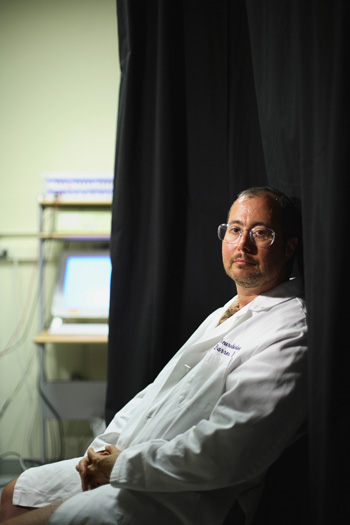Personal experience stokes a passion to change the culture of science
Timothy Archibald |
|
 |
|
By AMY ADAMS
It all started innocently enough. Ben Barres, MD, PhD, did what many Stanford faculty members do — he wrote a commentary for Nature.
Three thousand e-mails, eight book offers, a handful of invitations to advisory boards and hundreds of media interviews and speaking requests later and Barres is seeing some results.
How a mild-mannered neurobiologist got involved in such a media frenzy is a story that began well before Barres’ July commentary. About 10 years ago Ben Barres — Barbara at the time — began living as a man. Because of that, Barres has seen science from both sides, and what he’s learned is that it’s easier being a man. Grants are more plentiful. Awards are more frequent. Colleagues are more easily impressed.
“It’s an outrage. An absolute outrage,” the 51-year-old neurobiology professor says about the inequality.
His July commentary wasn’t simply an excuse to highlight the bias he faced as a woman — although he does point out a few instances in which that was the case. Instead, he argued that overwhelming scientific evidence of gender bias exists and that universities should take steps to overcome this bias. This isn’t a new argument, but it’s one that he was uniquely able to make. “I’m tenured; I’m transgendered. I can’t be fired, and people can’t think less of me than they already do,” he says.
The basis for Barres’ argument is this: Data show that even men and women who claim to be unbiased judge women more critically. Among the evidence are studies finding that a woman applying for a research grant must be three times more productive than a man to be considered equally competent. Although Barres doesn’t see an easy fix to this problem, he does think competitions for grants, jobs or awards could be designed to provide equal opportunities. And since the data show that men and women think through problems differently, institutions should have both men and women in leadership positions to get the widest possible viewpoints.
His ideas clearly resonated. The thousands of e-mails Barres received told stories of women who were fed up with male-dominated professions, husbands who saw their wives repeatedly overlooked, and fathers who worried about their daughters having equal opportunities. “One thing I got out of this is how many well-meaning people there are, men and women,” he says.
Barres thinks it’s more likely that change will come about when more women are in decision-making positions. So he’s working on that. At the medical school, he’s on a task force that promotes faculty hiring policies that avoid inherent biases. He has also worked to include more female reviewers in choosing recipients of the prestigious NIH Pioneer award. Succeeding there, he has turned his attention to the coveted Howard Hughes investigator positions. After two years of lobbying for change, Barres said that this spring faculty members will be able to nominate themselves for the posts instead of having the institutions select the nominees.
It’s his interest in having women in positions to influence women-friendly policies that has turned Barres’ attention in a new direction. He wants to see a Supreme Court made up equally of men and women. “If men and women with the same legal data come to different conclusions, then how is it fair to have a mostly male Supreme Court?” he asks. If Barres’ past is anything to judge by, he’ll soon be taking action.
Comments? Contact Stanford Medicine at

